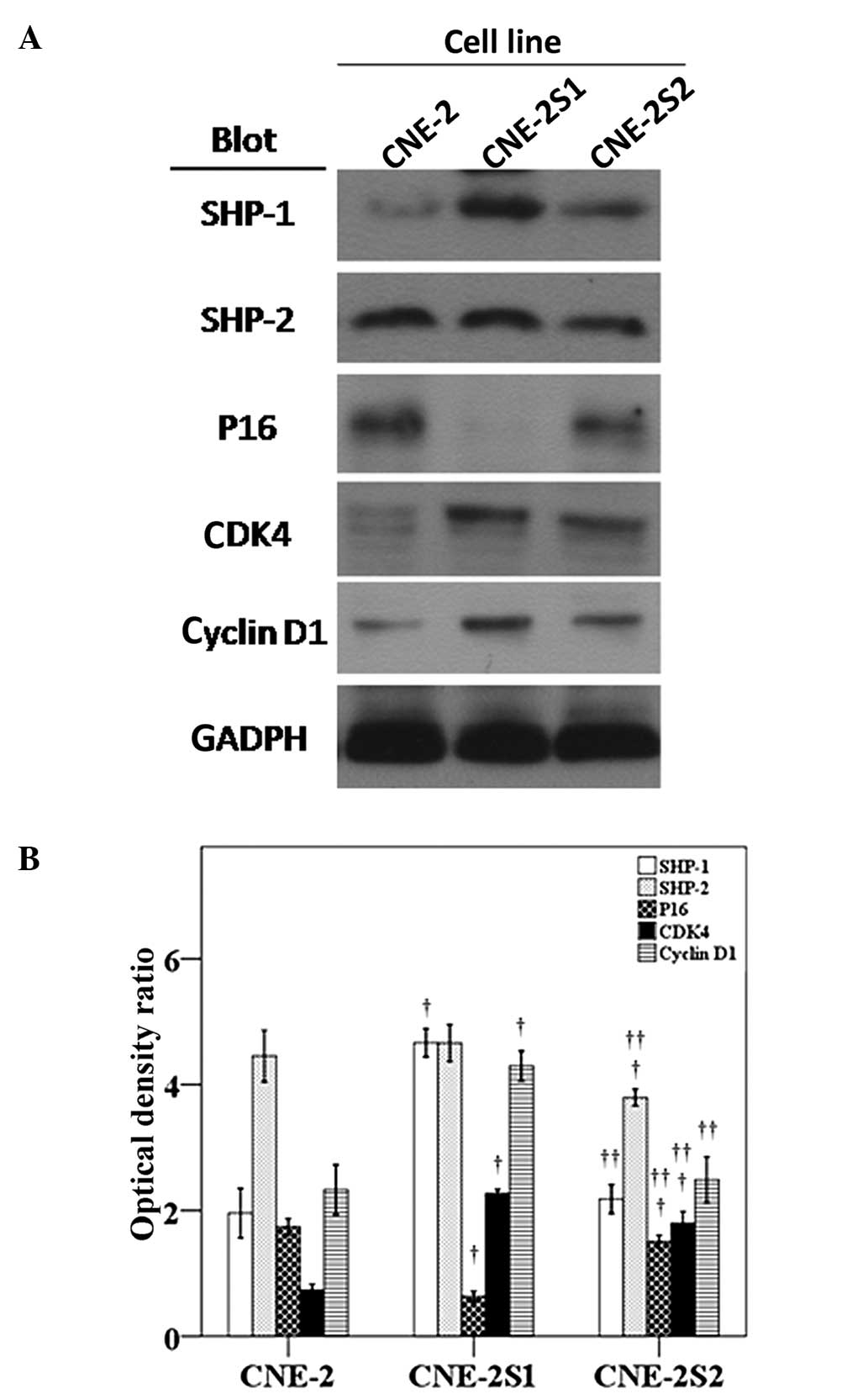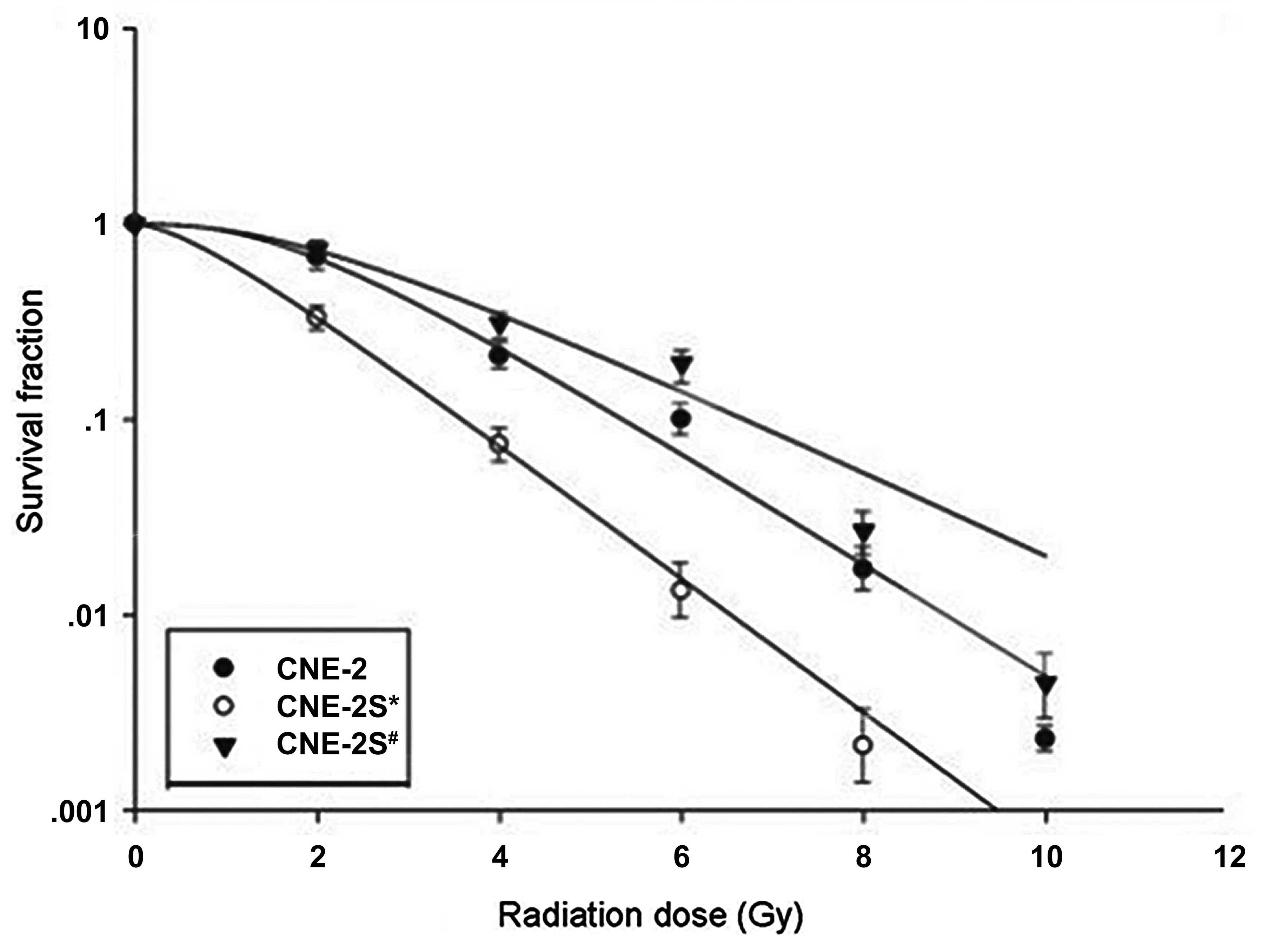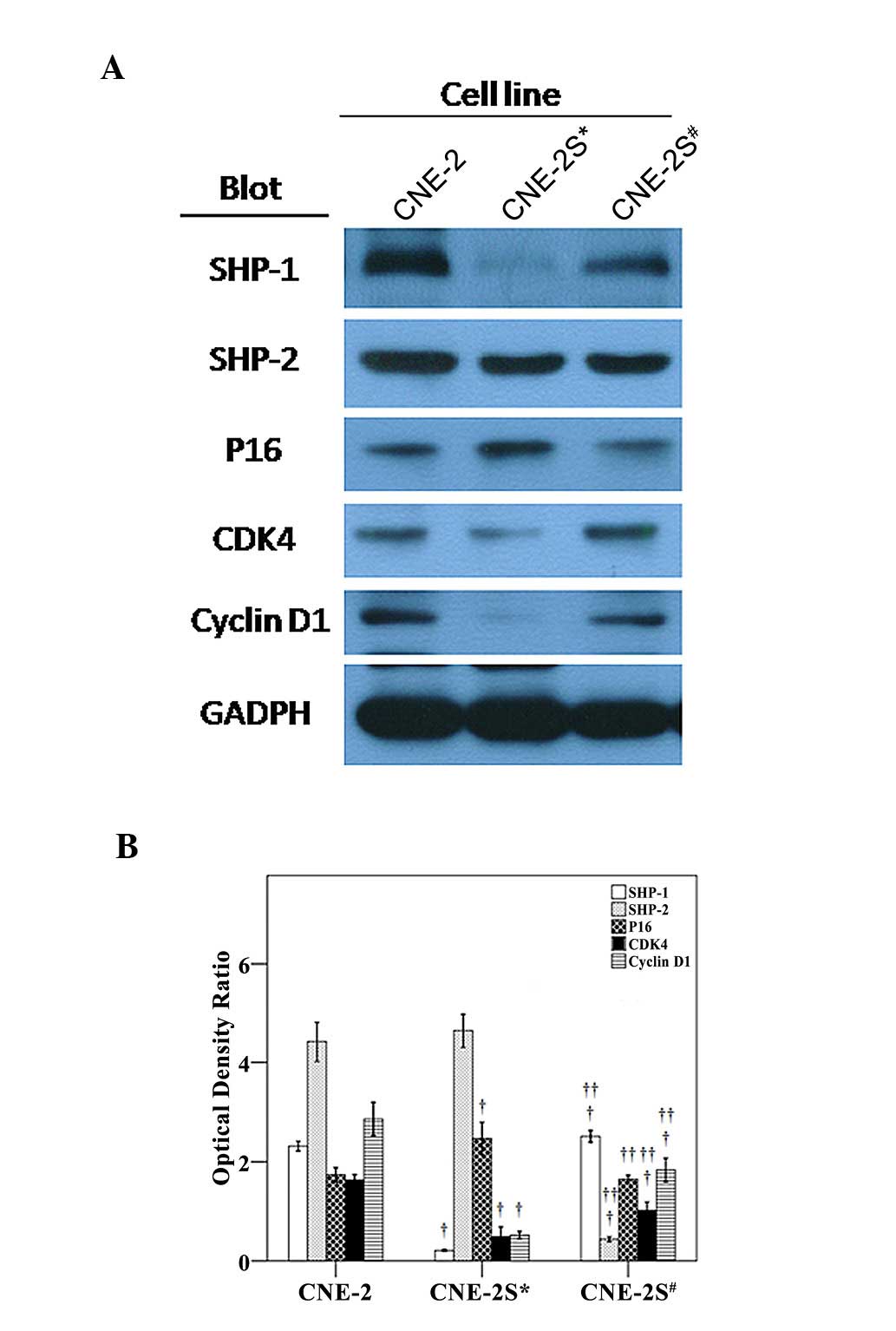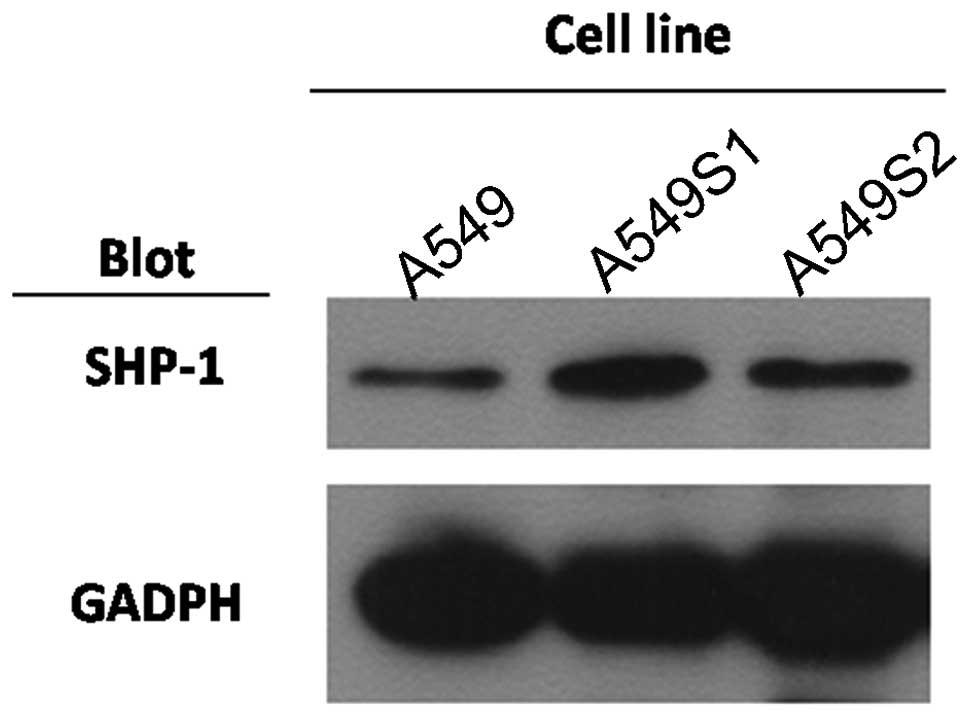|
1
|
Tulalamba W and Janvilisri T:
Nasopharyngeal carcinoma signaling pathway: an update on molecular
biomarkers. Int J Cell Biol. 2012:5946812012. View Article : Google Scholar : PubMed/NCBI
|
|
2
|
Chang ET and Adami HO: The enigmatic
epidemiology of nasopharyngeal carcinoma. Cancer Epidemiol
Biomarkers Prev. 15:1765–1777. 2006. View Article : Google Scholar : PubMed/NCBI
|
|
3
|
Lee AW, Sze WM, Au JS, Leung SF, Leung TW,
Chua DT, Zee BC, Law SC, Teo PM, Tung SY, Kwong DL and Lau WH:
Treatment results for nasopharyngeal carcinoma in the modern era:
the Hong Kong experience. Int J Radiat Oncol Biol Phys.
61:1107–1116. 2005. View Article : Google Scholar : PubMed/NCBI
|
|
4
|
Lee AW, Poon YF, Foo W, Law SC, Cheung FK,
Chan DK, Tung SY, Thaw M and Ho JH: Retrospective analysis of 5037
patients with nasopharyngeal carcinoma treated during 1976–1985
overall survival and patterns of failure. Int J Radiat Oncol Biol
Phys. 23:261–270. 1992.PubMed/NCBI
|
|
5
|
Langendijk JA, Leemans CR, Buter J,
Berkhof J and Slotman BJ: The additional value of chemotherapy to
radiotherapy in locally advanced nasopharyngeal carcinoma: a
meta-analysis of the published literature. J Clin Oncol.
22:4604–4612. 2004. View Article : Google Scholar : PubMed/NCBI
|
|
6
|
Lin JC, Jan JS, Hsu CY, Liang WM, Jiang RS
and Wang WY: Phase III study of concurrent chemoradiotherapy versus
radiotherapy alone for advanced nasopharyngeal carcinoma: positive
effect on overall and progression-free survival. J Clin Oncol.
21:631–637. 2003. View Article : Google Scholar
|
|
7
|
Wee J, Tan EH, Tai BC, Wong HB, Leong SS,
Tan T, Chua ET, Yang E, Lee KM, Fong KW, Tan HS, Lee KS, Loong S,
Sethi V, Chua EJ and Machin D: Randomized trial of radiotherapy
versus concurrent chemoradiotherapy followed by adjuvant
chemotherapy in patients with American Joint Committee on
Cancer/International Union against cancer stage III and IV
nasopharyngeal cancer of the endemic variety. J Clin Oncol.
23:6730–6738. 2005. View Article : Google Scholar
|
|
8
|
Feng XP, Yi H, Li MY, Li XH, Yi B, Zhang
PF, Li C, Peng F, Tang CE, Li JL, Chen ZC and Xiao ZQ:
Identification of biomarkers for predicting nasopharyngeal
carcinoma response to radiotherapy by proteomics. Cancer Res.
70:3450–3462. 2010. View Article : Google Scholar : PubMed/NCBI
|
|
9
|
Dent P, Yacoub A, Contessa J, Caron R,
Amorino G, Valerie K, Hagan MP, Grant S and Schmidt-Ullrich R:
Stress and radiation-induced activation of multiple intracellular
signaling pathways. Radiat Res. 159:283–300. 2003. View Article : Google Scholar : PubMed/NCBI
|
|
10
|
Sung FL, Hui EP, Tao Q, Li H, Tsui NB,
Dennis Lo YM, Ma BB, To KF, Harris AL and Chan AT: Genome-wide
expression analysis using microarray identified complex signaling
pathways modulated by hypoxia in nasopharyngeal carcinoma. Cancer
Lett. 253:74–88. 2007. View Article : Google Scholar
|
|
11
|
Morrison JA, Gulley ML, Pathmanathan R and
Raab-Traub N: Differential signaling pathways are activated in the
Epstein-Barr virus-associated malignancies nasopharyngeal carcinoma
and Hodgkin lymphoma. Cancer Res. 64:5251–5260. 2004. View Article : Google Scholar
|
|
12
|
Li L, Tao Q, Jin H, van Hasselt A, Poon
FF, Wang X, Zeng MS, Jia WH, Zeng YX, Chan AT and Cao Y: The tumor
suppressor UCHL1 forms a complex with p53/MDM2/ARF to promote p53
signaling and is frequently silenced in nasopharyngeal carcinoma.
Clin Cancer Res. 16:2949–2958. 2010. View Article : Google Scholar : PubMed/NCBI
|
|
13
|
Zeng ZY, Zhou YH, Zhang WL, Xiong W, Fan
SQ, Li XL, Luo XM, Wu MH, Yang YX, Huang C, Cao L, Tang K, Qian J,
Shen SR and Li GY: Gene expression profiling of nasopharyngeal
carcinoma reveals the abnormally regulated Wnt signaling pathway.
Hum Pathol. 38:120–133. 2007. View Article : Google Scholar : PubMed/NCBI
|
|
14
|
Oka T, Yoshino T, Hayashi K, Ohara N,
Nakanishi T, Yamaai Y, Hiraki A, Sogawa CA, Kondo E, Teramoto N,
Takahashi K, Tsuchiyama J and Akagi T: Reduction of hematopoietic
cell-specific tyrosine phosphatase SHP-1 gene expression in natural
killer cell lymphoma and various types of lymphomas/leukemias:
combination analysis with cDNA expression array and tissue
microarray. Am J Pathol. 159:1495–1505. 2001. View Article : Google Scholar
|
|
15
|
Neel BG, Gu H and Pao L: The ‘Shp’ing
news: SH2 domain-containing tyrosine phosphatases in cell
signaling. Trends Biochem Sci. 28:284–293. 2003.
|
|
16
|
Mittal Y, Pavlova Y, Garcia-Marcos M and
Ghosh P: Src homology domain 2-containing protein-tyrosine
phosphatase-1 (SHP-1) binds and dephosphorylates
G(alpha)-interacting, vesicle-associated protein (GIV)/Girdin and
attenuates the GIV-phosphatidylinositol 3-kinase (PI3K)-Akt
signaling pathway. J Biol Chem. 286:32404–32415. 2011. View Article : Google Scholar
|
|
17
|
Beyaert R: SHP works a double shift to
control TLR signaling. Nat Immunol. 12:725–727. 2011. View Article : Google Scholar : PubMed/NCBI
|
|
18
|
Prasad S, Pandey MK, Yadav VR and Aggarwal
BB: Gambogic acid inhibits STAT3 phosphorylation through activation
of protein tyrosine phosphatase SHP-1: potential role in
proliferation and apoptosis. Cancer Prev Res (Phila). 4:1084–1094.
2011. View Article : Google Scholar : PubMed/NCBI
|
|
19
|
López-Ruiz P, Rodriguez-Ubreva J, Cariaga
AE, Cortes MA and Colás B: SHP-1 in cell-cycle regulation.
Anticancer Agents Med Chem. 11:89–98. 2011.
|
|
20
|
Rodríguez-Ubreva FJ, Cariaga-Martinez AE,
Cortés MA, Romero-De Pablos M, Ropero S, López-Ruiz P and Colás B:
Knockdown of protein tyrosine phosphatase SHP-1 inhibits G1/S
progression in prostate cancer cells through the regulation of
components of the cell-cycle machinery. Oncogene. 29:345–355.
2010.PubMed/NCBI
|
|
21
|
López-Ruiz P, Rodriguez-Ubreva J, Cariaga
AE, Cortes MA and Colás B: SHP-1 in cell-cycle regulation.
Anticancer Agents Med Chem. 11:89–98. 2011.
|
|
22
|
Yu Z, Maoui M, Zhao ZJ, Li Y and Shen SH:
SHP-1 dephosphorylates 3BP2 and potentially downregulates
3BP2-mediated T cell antigen receptor signaling. FEBS J.
273:2195–2205. 2006. View Article : Google Scholar : PubMed/NCBI
|
|
23
|
Zhang J and Shen B: SHP limits TLR
signaling, an inducible transcriptional corepressor. Cell Mol
Immunol. 8:445–446. 2011. View Article : Google Scholar : PubMed/NCBI
|
|
24
|
Iype T, Sankarshanan M, Mauldin IS,
Mullins DW and Lorenz U: The protein tyrosine phosphatase SHP-1
modulates the suppressive activity of regulatory T cells. J
Immunol. 185:6115–6127. 2010. View Article : Google Scholar : PubMed/NCBI
|
|
25
|
Biskup C, Böhmer A, Pusch R, Kelbauskas L,
Gorshokov A, Majoul I, Lindenau J, Benndorf K and Böhmer FD:
Visualization of SHP-1-target interaction. J Cell Sci.
117:5165–5178. 2004. View Article : Google Scholar : PubMed/NCBI
|
|
26
|
Zhu Z, Oh SY, Cho YS, Zhang L, Kim YK and
Zheng T: Tyrosine phosphatase SHP-1 in allergic and anaphylactic
inflammation. Immunol Res. 47:3–13. 2010. View Article : Google Scholar : PubMed/NCBI
|
|
27
|
Seo DW, Li H, Qu CK, Oh J, Kim YS, Diaz T,
Wei B, Han JW and Stetler-Stevenson WG: Shp-1 mediates the
antiproliferative activity of tissue inhibitor of
metalloproteinase-2 in human microvascular endothelial cells. J
Biol Chem. 281:3711–3721. 2006. View Article : Google Scholar : PubMed/NCBI
|
|
28
|
Yip SS, Crew AJ, Gee JM, Hui R, Blamey RW,
Robertson JF, Nicholson RI, Sutherland RL and Daly RJ:
Up-regulation of the protein tyrosine phosphatase SHP-1 in human
breast cancer and correlation with GRB2 expression. Int J Cancer.
88:363–368. 2000. View Article : Google Scholar : PubMed/NCBI
|
|
29
|
Ketroussi F, Giuliani M, Bahri R, Azzarone
B, Charpentier B and Durrbach A: Lymphocyte cell-cycle inhibition
by HLA-G is mediated by phosphatase SHP-2 and acts on the mTOR
pathway. PLoS One. 6:e227762011. View Article : Google Scholar : PubMed/NCBI
|
|
30
|
Yuan L, Yu WM and Qu CK: DNA
damage-induced G2/M checkpoint in SV40 large T antigen-immortalized
embryonic fibroblast cells requires SHP-2 tyrosine phosphatase. J
Biol Chem. 278:42812–42820. 2003. View Article : Google Scholar
|
|
31
|
Yuan L, Yu WM, Yuan Z, Haudenschild CC and
Qu CK: Role of SHP-2 tyrosine phosphatase in the DNA damage-induced
cell death response. J Biol Chem. 278:15208–15216. 2003. View Article : Google Scholar
|
|
32
|
Jiang J, Jin MS, Kong F, Wang YP, Jia ZF,
Cao DH, Ma HX, Suo J and Cao XY: Increased expression of tyrosine
phosphatase SHP-2 in Helicobacter pylori-infected gastric
cancer. World J Gastroenterol. 19:575–580. 2013. View Article : Google Scholar : PubMed/NCBI
|
|
33
|
Meng F, Zhao X and Zhang S: Expression and
significance of SHP-2 in human papillomavirus infected cervical
cancer. J Huazhong Univ Sci Technolog Med Sci. 32:247–251. 2012.
View Article : Google Scholar : PubMed/NCBI
|
|
34
|
Hall M and Peters G: Genetic alterations
of cyclins, cyclin-dependent kinases and Cdk inhibitors in human
cancer. Adv Cancer Res. 68:67–108. 1996. View Article : Google Scholar : PubMed/NCBI
|
|
35
|
Hwang CF, Cho CL, Huang CC, Wang JS, Shih
YL, Su CY and Chang HW: Loss of cyclin D1 and p16 expression
correlates with local recurrence in nasopharyngeal carcinoma
following radiotherapy. Ann Oncol. 13:1246–1251. 2002. View Article : Google Scholar
|
|
36
|
Gulley ML, Nicholls JM, Schneider BG, Amin
MB, Ro JY and Geradts J: Nasopharyngeal carcinomas frequently lack
the p16/MTS1 tumor suppressor protein but consistently express the
retinoblastoma gene product. Am J Pathol. 152:865–869. 1998.
|
|
37
|
Pearce AG, Segura TM, Rintala AC,
Rintala-Maki ND and Lee H: The generation and characterization of a
radiation-resistant model system to study radioresistance in human
breast cancer cells. Radiat Res. 156:739–750. 2001. View Article : Google Scholar
|
|
38
|
Hall EJ and Giaccia A: Radiobiology for
the Radiologist. 7th edition. Section I, Chapter 3: Cell survival
curves. Lippincott Williams & Wilkins; New York: 2011
|
|
39
|
Larsen JK, Landberg G and Roos G:
Detection of proliferating cell nuclear antigen. Methods Cell Biol.
63:419–431. 2001.PubMed/NCBI
|
|
40
|
Shimura T: Acquired radioresistance of
cancer and the AKT/GSK3β/cyclin D1 overexpression cycle. J Radiat
Res. 52:539–544. 2011.PubMed/NCBI
|
|
41
|
Deorukhkar A and Krishnan S: Targeting
inflammatory pathways for tumor radiosensitization. Biochem
Pharmacol. 80:1904–1914. 2010. View Article : Google Scholar : PubMed/NCBI
|
|
42
|
Brizel DM, Sibley GS, Prosnitz LR, Scher
RL and Dewhirst MW: Tumor hypoxia adversely affects the prognosis
of carcinoma of the head and neck. Int J Radiat Oncol Biol Phys.
38:285–289. 1997. View Article : Google Scholar : PubMed/NCBI
|
|
43
|
Feng Z, Xu S, Liu M, Zeng YX and Kang T:
Chk1 inhibitor Gö6976 enhances the sensitivity of nasopharyngeal
carcinoma cells to radiotherapy and chemotherapy in vitro and in
vivo. Cancer Lett. 297:190–197. 2010.
|
|
44
|
Li AA, Ng E, Shi W, Lee A, Chia M, Liu TJ,
Huang D, O’Sullivan B, Gullane P and Liu FF: Potential efficacy of
p16 gene therapy for EBV-positive nasopharyngeal carcinoma. Int J
Cancer. 110:452–458. 2004. View Article : Google Scholar : PubMed/NCBI
|
|
45
|
Gupta S and Ahmed MM: A global perspective
of radiation-induced signal transduction pathways in cancer
therapeutics. Indian J Exp Biol. 42:1153–1176. 2004.PubMed/NCBI
|
|
46
|
Storozhuk Y, Sanli T, Hopmans SN, Schultz
C, Farrell T, Cutz JC, Steinberg GR, Wright J, Singh G and
Tsakiridis T: Chronic modulation of AMP-Kinase, Akt and mTOR
pathways by ionizing radiation in human lung cancer xenografts.
Radiat Oncol. 7:712012. View Article : Google Scholar : PubMed/NCBI
|
|
47
|
Valerie K, Yacoub A, Hagan MP, Curiel DT,
Fisher PB, Grant S and Dent P: Radiation-induced cell signaling:
inside-out and outside-in. Mol Cancer Ther. 6:789–801. 2007.
View Article : Google Scholar : PubMed/NCBI
|
















